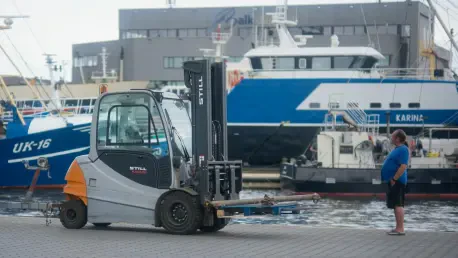The acquisition of Doosan’s forklift division by Bobcat marked a significant turn for both companies, propelling a shift in Bobcat’s strategic focus toward the material handling industry. Traditionally a name synonymous with tough construction machinery, Bobcat is now venturing into enhancing the reliability and functionality of forklifts. This move aligns with emerging demands for robust and cost-efficient solutions in the small to medium-sized enterprise (SME) market. As the manufacturing and logistics sectors continue to evolve, there is a pressing need for machines that offer both durability and performance without overwhelming complexity. Bobcat’s integration of Doosan’s expertise with its construction pedigree is an attempt to address these gaps in the forklift sector. By blending their strengths, Bobcat seeks to create a powerful synergy that not only respects Doosan’s legacy but also sets a new standard for reliability in forklift operations. This strategic move comes at a time when industry trends are veering towards sustainable practices and cost-effective operational capabilities.
Bobcat’s Strategic Vision and Durable Design
Bobcat’s acquisition was not merely a business expansion but a calculated maneuver to redefine its brand presence in the material handling market. Unlike other acquisitions driven solely by growth ambitions, Bobcat envisions a seamless blend of its hallmark durability with Doosan’s established reliability. By capitalizing on the strengths of both entities, Bobcat aims to deliver a product line that addresses the nuanced requirements of its targeted clientele. This focus is evident in the strategy of Jan Droogendijk, Bobcat’s Customer Strategy Manager, who identifies SMEs as the primary market. By targeting firms with minimal truck requirements but high expectations for efficiency, Bobcat plans to provide a competitively durable product. This market tends to prioritize functionality and longevity over intricate, high-maintenance features. Such strategic targeting ensures that Bobcat’s offerings cater effectively to businesses for whom forklifts are long-term, integral investments.
A significant part of Bobcat’s strategy is encapsulated in its commitment to heavy-duty design. This philosophy stems from the belief that longevity equates to cost-effectiveness, a principle that strongly resonates with SME buyers. Bobcat’s forklifts are therefore constructed with a focus on longevity by employing robust structural materials. This approach reduces the necessity for frequent replacements, offering businesses a reliable, long-lasting solution. By heavily focusing on durability, Bobcat perpetuates the reliability once associated with Doosan while incorporating advances that ensure its relevance in today’s competitive market. This dedication to upholding a rugged design characteristic of construction machinery provides a strategic edge, ensuring the forklifts meet the demand for sturdy machines capable of enduring rigorous daily use.
Rebranding, Innovation, and Market Adaptation
Following the acquisition, Bobcat embarked on a rebranding journey that goes beyond simple aesthetics, bringing to the forefront efficiencies in parts integration and logistical improvements. With the consolidation of distribution centers, Bobcat ensures enhanced logistics, contributing to shorter lead times and better aftermarket support. This evolution in operational processes reinforces their foothold in the European market. The transition from Doosan to Bobcat is also strategic from a branding perspective, enabling the company to leverage a powerful name while maintaining the trust that existing Doosan customers have placed in the reliability of the products. Bobcat’s ability to combine proven reliability with improved service infrastructure serves as a testament to its commitment to quality and customer satisfaction.
In terms of technological advancement, Bobcat is strategically venturing into electrification, preparing to introduce forklifts equipped with lithium-ion batteries. However, rather than pursuing a wholesale shift, Bobcat maintains a balanced portfolio with internal combustion engines as an option. This dual approach is crucial given varying global regulations and the specific energy requirements of industries where diesel engines remain indispensable. Bobcat’s acknowledgment of these diverse needs reflects a nuanced understanding of its market, ensuring that its offerings remain relevant across different sectors. This strategic adaptability champions a pragmatic approach to innovation, allowing flexibility in catering to both green energy preferences and conventional engine demands.
Dealer Network and Market Expansion
Bobcat’s rebranding efforts acted as a catalyst for reevaluating and optimizing its dealer network, an essential aspect of deepening market penetration and enhancing customer service. Successfully retaining a significant portion of Doosan’s established dealer network while integrating additional resources underscores Bobcat’s strategic intent to bolster its service capabilities. This move not only broadens Bobcat’s geographical reach but also enhances its capacity to provide timely support—a critical factor in maintaining operational efficiency for businesses relying on these machines. The strategic alignment of Bobcat’s dealer network translates into enhanced visibility and market presence, significantly advancing its objectives in the European sector.
Through innovative mergers with existing dealers, Bobcat facilitates a robust support framework, intensifying service quality and ensuring availability where it’s required the most. This optimized network provides users with streamlined access to services and parts, promoting seamless business continuity. Bobcat’s dealer strategy is a critical component of its commitment to customer satisfaction, meeting service expectations by reducing response times and ensuring product availability. Such alignment with market expectations fortifies customer trust, making Bobcat a formidable presence in the material handling arena. This approach not only ensures continued customer loyalty but also attracts new clients looking for dependable solutions.
Conclusion: A Dynamic Path Forward
The acquisition of Doosan’s forklift division by Bobcat marks a pivotal shift for both companies, pushing Bobcat’s strategy toward the material handling sector. Known for its tough construction equipment, Bobcat is entering the forklift domain, enhancing reliability and functionality. This strategy responds to growing demands for durable, cost-efficient solutions in small to medium-sized enterprises (SMEs). As manufacturing and logistics progress, machines offering durability, efficiency, and simplicity are increasingly sought after. Bobcat aims to meld Doosan’s forklift proficiency with its own construction expertise, addressing current gaps in the forklift market. Blending their strengths, Bobcat intends to foster a robust synergy honoring Doosan’s legacy while establishing new benchmarks for forklift reliability. This strategic move coincides with industry trends favoring sustainable practices and economical operations. Merging Bobcat’s existing knowledge with Doosan’s insights propels both toward a future rich in innovation and operational excellence.









